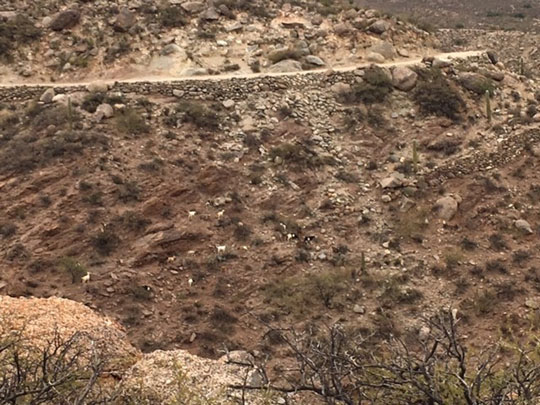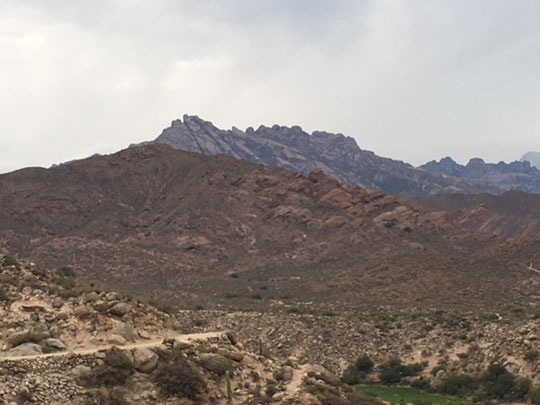GUALFIN, ARGENTINA – “What business school did you go to?”
We were joking, of course.
But the two young men needed an alternative point of view. In the course of getting their MBAs in Chicago, they had picked up some bad ideas about investing.
“Shouldn’t we just buy a low-cost ETF that tracks the S&P 500 and sit tight?” one had asked. “That’s what Warren Buffett recommends. We’re young. Over the long run, it should pay off.”
Legendary Place
But let’s back up…
These questions came in such extraordinary and unlikely circumstances, we should probably tell you about the whole adventure.
On Monday, we were invited to lunch at a neighbor’s house. We knew where the house was; we located it on Google Earth. And from the hill behind our house, we can see the distant valley where it is located.
Besides, it is a legendary place… part of the history of Argentina.
“Yes,” explained the owner. “The Spanish were here even before they began the general conquest of the province. And when the famous conquistador – the first one – Diego de Almagro arrived here, he found chickens.
“Chickens had to come from Spain. They weren’t native to the New World. They were left here by the first Spanish explorers in the 16th century. Nobody knows their names, but they were here.”
But we are getting ahead of ourselves…
Although the valley was visible from our ranch, it took three hours of rough-road driving to get there. We had to leave our valley and follow the Calchaquí River north to a village called Seclantás.
There, we turned to the west… and kept going for the next hour and a half.
Warm Greeting
The drive was magnificent…
The road snaked up and down mountains. Much of the terrain had a fantastical appearance, as though it had been designed by a computer game company.
There were soaring mountains, huge rocky peaks, and glistening rivers far below. One stretch of the road looked as though it had been built by the Incas; Elizabeth closed her eyes as we hugged the cliff so tightly, we almost scraped the paint off the side of the truck.


Bill navigates the difficult Argentine terrain
This far valley gets a lot more rainfall than ours. We get about 5 inches a year. Here, they get three times as much. There were trees, streams, and well-watered fields everywhere. Clouds hung over the mountaintops, delivering a light snow. Down below, it was still warm.
When we finally reached our destination, we were warmly greeted by a family from Buenos Aires.
Though the property – some 230,000 acres – has been in the family for more than 300 years, the owners have spent most of their time in the capital city for several generations.
Among them was one recent MBA graduate and a friend from California.
Neighbors, Not Tenants
“What a surprise to find you here,” we said.
“Everything here is surprising,” the Californian replied.
“We’re sorry to be late,” we apologized to the mistress of the house. “It took longer than we expected to get here.”
“Oh… that’s one of the surprising things,” she answered graciously.
“Time doesn’t count here. We’re too far from the rest of the world. And until a few years ago, we had even worse roads… and no bridges over the rivers.
“Since there’s only one way into and out of the valley, sometimes we’d get here and we couldn’t leave for weeks. People come when they can get here. And they stay as long as they want.”
The farm used to be much bigger, with 350 tenant farmers.
“My grandfather raised cattle here and sold them in Chile. They drove the cattle up over the mountain and across the desert. They had to put horseshoes on the cattle because the trail was so rocky. But I guess it paid.”
It probably stopped paying in the early 20th century. Then, the whole area went into decline. By the 1980s, the present owner found the main house almost in ruins. He restored it and now uses it regularly.
But he, too, ran into trouble with the originarios – the locals claiming indigenous rights to land around here – though they didn’t call themselves that back then.
They burnt crops and threatened to burn down the main house. Finally, the owner surrendered a large part of the productive area… and made peace.
“Now I have neighbors, not tenants,” he explained philosophically. “It’s much better this way.”
Crowded Trade
After a delicious and convivial lunch, the young men wanted to talk money.
“Why not just buy a low-cost ETF that tracks the S&P 500?” asked the Californian.
We gave an incomplete and unconvincing answer. Here, we’ll try to do better…
Chris Mayer, one of our top stock pickers, recently emailed us with the example of the popular Wintergreen Fund run by David Winters. It charges 2% a year. That doesn’t seem like a lot. But if the fund, in a typical year, produced a 4% gain, investors gave half of it to the manager.
Put another way, if you had $1 million in this fund, you would be writing a check to Mr. Winters for almost $20,000 a year.
That’s part of the reason record amounts of money have gone into low-cost ETFs that simply give you the returns of an index such as the S&P 500 or the Dow. Investors have gotten the message that they can participate in the stock market’s gains without having to research stocks or pay a manager to look after their money.
But there are several problems…
First and foremost, if you invest in “the market” rather than in particular stocks, you get whatever the market gives you. That can be good if you have the central bank pumping trillions into the financial economy. But it can be bad when the bubble finally pops.
“The performance of the last 30 years is based on the fraud,” we told the young men, “that you can get richer by putting more artificial credit into an economy at artificially low rates. At some point, that credit bubble is going to blow up. And when it does, stock prices could get cut in half and stay there for 20 years.
“That happens even without central bank manipulation, as it did after the stock crash of 1929… and again after the bull market peak in 1966.
“You don’t make money by being the last one into a crowded trade. Especially when the trade is based on a scam. Just because people have done well by tracking the S&P 500 in the current bull market – from 2009 to today – don’t expect that you’ll do anywhere near as well in the future.
“Central banks worldwide have boosted their balance sheets by some $12 trillion to make those ETFs rise. That’s not a good reason to buy them.”
Even Bigger Losses
But ETFs set you up for even bigger losses…
An index such as the S&P 500 is “cap-weighted.” That means you end up owning more of the most popular stocks in an index – the ones with the biggest market “caps” – and fewer of the less popular ones.
These popular stocks tend to get bid up too much more than they are worth. And then when the market goes down – it always does – they’re the ones that will lose the most.
A lot of ETF buyers are not serious investors. They’re looking for easy money in a rising market. When the market goes down, they’ll bail out fast.
Look, you don’t get something for nothing. That’s why research pays off. It gets you away from the popular stocks in the big indexes. You have the chance of getting into companies that are reasonably priced, well-run, and more profitable than their peers.
Over the long run, those companies – chosen carefully and bought at fair prices – might prove to be good investments. ETFs? Probably not.
Tomorrow… a more fundamental reason why the big index-tracking ETFs (with exceptions for specific sectors… or country funds…) probably won’t make you rich.
Regards,
![]()
Bill
Category: Economics

